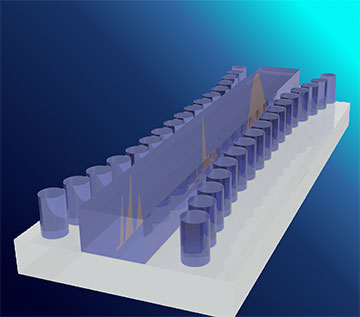
Left: Singapore University of Technology and Design Ph.D. student and lead author Ezgi Sahin holds the experimental chip. Right: close-up view of the chip. [Image: Singapore University of Technology and Design]
One-dimensional solitons, also known as Bragg solitons, propagate well down optical fibers, but not through silicon chips, due to strong nonlinear effects. Also, the type of silicon nitride used in complementary metal-oxide semiconductor (CMOS) devices constrains the propagation of such pulses at telecommunications wavelengths.
Recently, researchers based in Australia and Singapore have shown how to manipulate Bragg solitons on a CMOS chip (Las. Phot. Rev., doi: 10.1002/lpor.201900114). The work could help speed up future telecommunications networks, in which signals from optical fibers meet electronic processing equipment.
Solitons and silicon
The device from the University of Sydney, Australia, and the Singapore University of Technology and Design (SUTD), Singapore, incorporates ultra-silicon-rich nitride (USRN), which has the chemical formula Si7N3. (“Regular” silicon nitride's formula is Si3N4.) Team members realized that the high-silicon compound had a Kerr nonlinearity—a light-induced change in refractive index—an order of magnitude higher than the ordinary semiconductor compound used in integrated circuits. Fortunately, USRN works well with other components of CMOS electronics.
“Solitons underpin crucial applications in ultrafast optics, communications and signal processing,” says the lead researcher, SUTD doctoral candidate Ezgi Sahin.
Sahin and her collaborators fabricated a cladding-modulated Bragg grating that looks like a rectangular block of USRN between two rows of round pillars, all supported by silicon dioxide cladding. The researchers then sent signals from a near-infrared mode-locked laser, wave shaper and erbium-doped fiber amplifier through the device via a technique called frequency-resolved electrical gating, which measured the temporal shape and phase of the transmitted pulses.

Artist's impression of the Bragg grating structure on a silicon substrate. [Image: University of Sydney / Singapore University of Technology and Design]
Continued collaboration
Mathematical modeling of the experimental inputs and outputs showed that the USRN device achieved a compression factor of 5.7 times through high-order soliton compression within the device, as well as time‐resolved measurements of soliton fission, with negligible nonlinear loss.
Dawn Tan, who heads the photonics devices and systems group at SUTD, says it took many design and fabrication process refinements before the team came up with high-quality Bragg gratings with the spectral characteristics needed for these experiments.
The researchers are continuing their collaboration with OSA Fellow Benjamin Eggleton of the University of Sydney, who first demonstrated Bragg solitons two decades ago. The team members intend to continue their exploration of soliton fission dynamics and perhaps develop new on-chip light sources.
